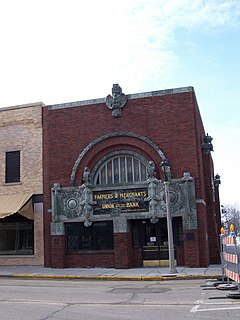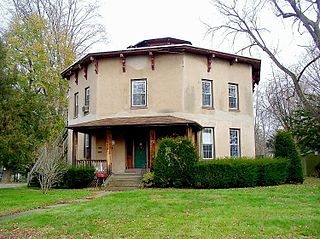
The Caguana Ceremonial Ball Courts Site is an archaeological site located in Caguana, Utuado in Puerto Rico, considered to be one of the most important Pre-Columbian sites in the West Indies. The site is known for its well-preserved ceremonial ball courts and petroglyph-carved monoliths. Studies estimate the in-situ courts to be over 700 years old, built by the Taíno around 1270 AD.

The Samuel J. Tilden House is a historic townhouse pair at 14-15 Gramercy Park South in Manhattan, New York City. Built in 1845, it was the home of Samuel J. Tilden (1814–1886), former governor of New York, a fierce opponent of the Tweed Ring and Tammany Hall, and the losing presidential candidate in the disputed 1876 election. Tilden lived in the brownstone from 1860 until his death in 1886. From 1881 to 1884, Calvert Vaux combined it with the row house next door, also built in 1845, to make the building that now stands, which has been described as "the height of Victorian Gothic in residential architecture" with Italian Renaissance style elements. Since 1906 it has been the headquarters of the National Arts Club, a private arts club.

The Duke Ellington House is a historic residence at 935 St. Nicholas Avenue, in Manhattan, New York City. Apartment 4A in this apartment house was the home of Duke Ellington (1899-1974), the noted African American composer and jazz pianist, from 1939 through 1961. It was listed on the National Register of Historic Places as a National Historic Landmark in 1976.

The Farmers and Merchants Union Bank is a historic commercial building at 159 West James Street in Columbus, Wisconsin, Built in 1919, it is the last of eight "jewel box" bank buildings designed by Louis Sullivan, and the next to last to be constructed. It was declared a National Historic Landmark in 1976 for its architecture.

Athenwood and the Thomas W. Wood Studio are a pair of distinctive historic buildings at 39 and 41 Northfield Street in Montpelier, Vermont, United States. The two Carpenter Gothic buildings were the home and studio of Thomas Waterman Wood, an American painter and native of Montpelier. The buildings, now private residences, were listed on the National Register of Historic Places in 1974.

The Joseph Williams Octagon House and the Gilbert Stancliff Octagon House are once-identical historic mid-1850s octagon houses located next to each other at 26 and 28 Marlborough Street in Portland, Connecticut. Constructed of Portland brownstone in the 1850s, they are distinctive as the only known pair of little-altered octagon houses in the state. The pair of houses, also known as the Octagon House Pair, was added to the National Register of Historic Places in 1976.

The Old Burying Ground is a historic cemetery on Pleasant and William Streets in Stoneham, Massachusetts. Established in 1726, it is the only surviving element of Stoneham's original town center, which also included a meeting house and school. It contains about 450 stones and fragments, with grave markers dating from 1728 to 1924. The stones were carved with motifs that were fairly typical of the period including urns, willows, cherubs, and winged death heads.

The Moraine Park Museum and Amphitheater, also known as the Moraine Park Lodge and the Moraine Park Visitor Center, are located in Moraine Park, a glaciated meadow between two moraines in Rocky Mountain National Park.

The U.S. Capitol Gatehouses and Gateposts — designed circa 1827 by celebrated architect Charles Bulfinch — originally stood on the grounds of the United States Capitol in Washington, D.C. Two of the gatehouses are listed on the National Register of Historic Places in their new locations.

St. Andrew's-by-the-Sea is a historic Episcopal chapel on Church Road, southeast of the junction with South Road and Route 1A in Rye, New Hampshire. Built in 1876, it is the only known religious work of Boston architects Winslow & Wetherell, and one of a modest number of churches built for summer vacationers in the state. It is an eclectic mix of Gothic Revival and Stick Style, and was listed on the National Register of Historic Places in 2001.

Mansfield Center Cemetery is a small cemetery in the Mansfield Center section of Mansfield, Connecticut. Established in 1693, it is one of the few surviving elements of Mansfield's early colonial settlement history. It also has a distinguished array of funerary markers carved by acknowledged masters across eastern Connecticut. It was listed on the National Register of Historic Places in 1992.

The Louisa County Courthouse in Wapello, Iowa, United States, was built in 1928. It was listed on the National Register of Historic Places in 1981 as a part of the County Courthouses in Iowa Thematic Resource. The courthouse is the fourth building the county has used for court functions and county administration.

The Dallas County Courthouse in Adel, Iowa, United States was built in 1902. It was individually listed on the National Register of Historic Places in 1973, and is a part of the County Courthouses in Iowa Thematic Resource. In 2009 it was included as a contributing property in the Adel Public Square Historic District. The current structure is the fourth building to house court functions and county administration.

The Church of St. Hubertus is a historic Catholic church in Chanhassen, Minnesota, United States, built in 1887. It was listed on the National Register of Historic Places in 1982 for having local significance in the themes of "community planning and development" and "exploration/settlement". It was nominated for symbolizing the Franciscan brotherhood that platted and grew the German Catholic settlement that became Chanhassen.

The U.S. Post Office-Laconia Main is a historic post office building at 33 Church Street in Laconia, New Hampshire. Occupying a prominent corner site near the city's central business district, it was built in 1916-17 and is a prominent regional example of Beaux Arts architecture. The building was listed on the National Register of Historic Places in 1986.

Fritz Chapel is a historic religious structure located northwest of Bellevue, Iowa, United States. The small roadside chapel was built by Mathias Fritz (1819-1889) in 1852. Fritz immigrated with his family to the United States from Luxembourg that same year. He built this chapel as an act of thanksgiving for the safe journey. The roughly 8-by-7-foot structure has limestone walls on three sides and is open on the front. It is capped with a gable roof. The walls inside the chapel are plastered, and it houses a small stone altar and a hand-carved crucifix. Located on the north side of a gravel road, it is surrounded by a picket fence. It was listed on the National Register of Historic Places in 1991.

The Indian Stones are a pair of historic markers on Vermont Route 106 in Reading, Vermont. Erected in 1799 in commemoration of a 1754 Native American raid, they are the oldest commemorative markers in the state, and among the oldest in the United States. They were mounted in a single granite slab in 1918, and were listed on the National Register of Historic Places in 1974.

The C.D. Bevington House and Stone Barn are historic buildings located in Winterset, Iowa, United States. Bevington was a pharmacist who passed through the area in 1849 on his way to the California Gold Rush. He settled in Winterset in 1853 after he made his fortune, and worked as a real estate agent and farmer. The house was built in the vernacular Gothic in 1856. The 2½-story brick structure features Gothic windows in the gable ends and carved bargeboards. The two porches were added around the turn of the 20th century. The two-story barn is composed of coursed rubble limestone. The lower level housed two horse stalls and stanchions for other livestock. A hay loft was on the upper level. The house and barn were listed on the National Register of Historic Places in 1976. Both buildings were donated to the Madison County Historical Society and are part of their museum complex.

The IANR Railroad Underpass is a historic structure located in Cedar Rapids, Iowa, United States. It carried railroad tracks for 24 feet (7.3 m) over Ely Road. The railroad probably built this stone arch bridge, which was completed in 1887. This kind of structure became more popular in the late 19th century as a railroad bridge because it was more durable than metal truss bridges, and they "projected a refined and sophisticated image." It features a semi-circular arch, a beltcourse, coursed-ashlar masonry, stepped wing walls that are flared, a parapet with projecting coping, and an elongated keystone with the date "1887" carved on it. The bridge was listed on the National Register of Historic Places in 1998. It now carries the Cedar River Recreation Trail over the street.






















